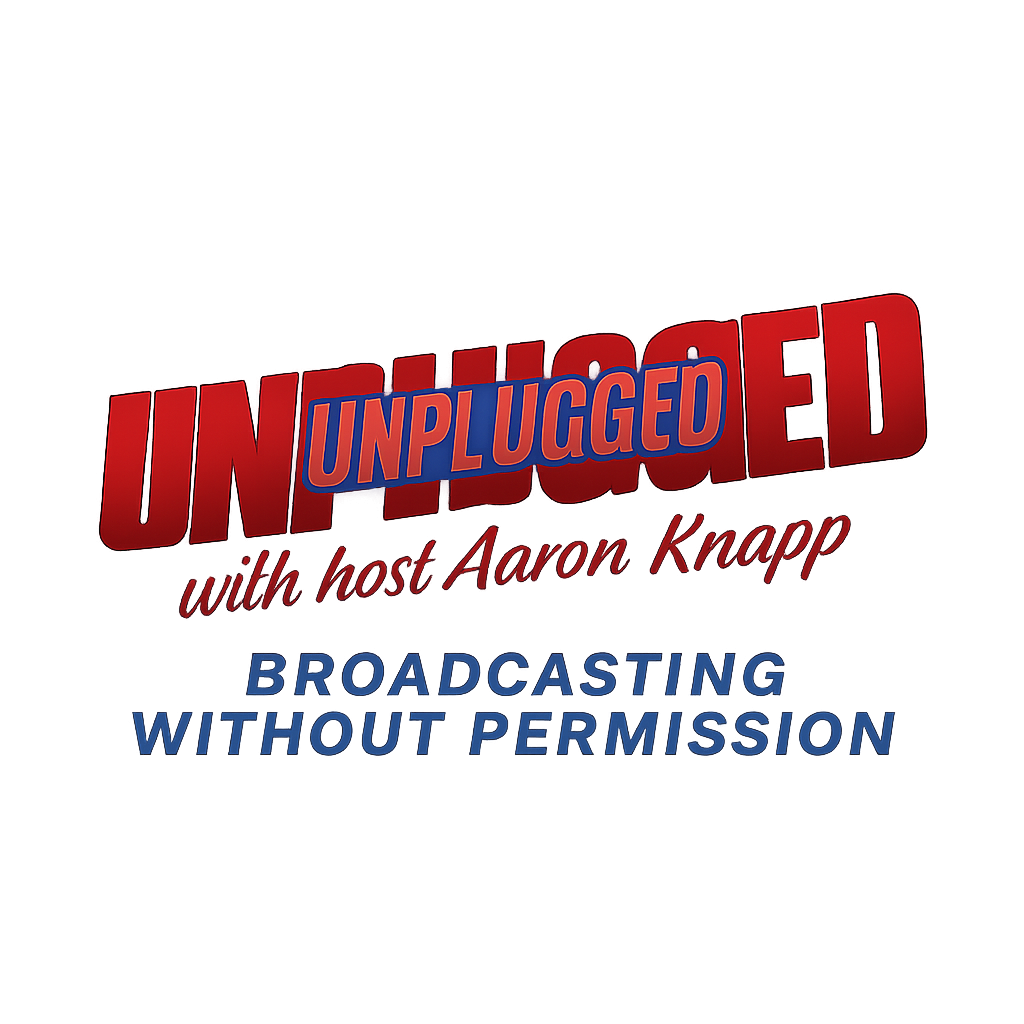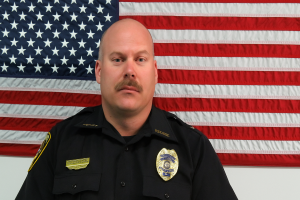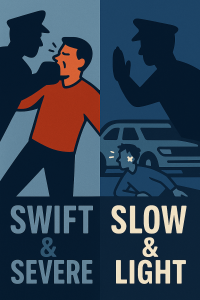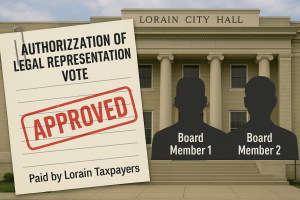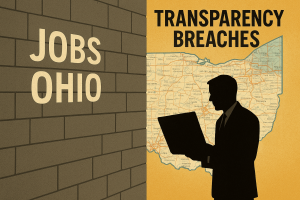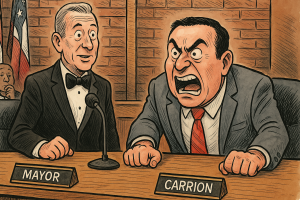Episode 10 – The Middlebrooks Tapes: What the Garrity Interviews Reveal
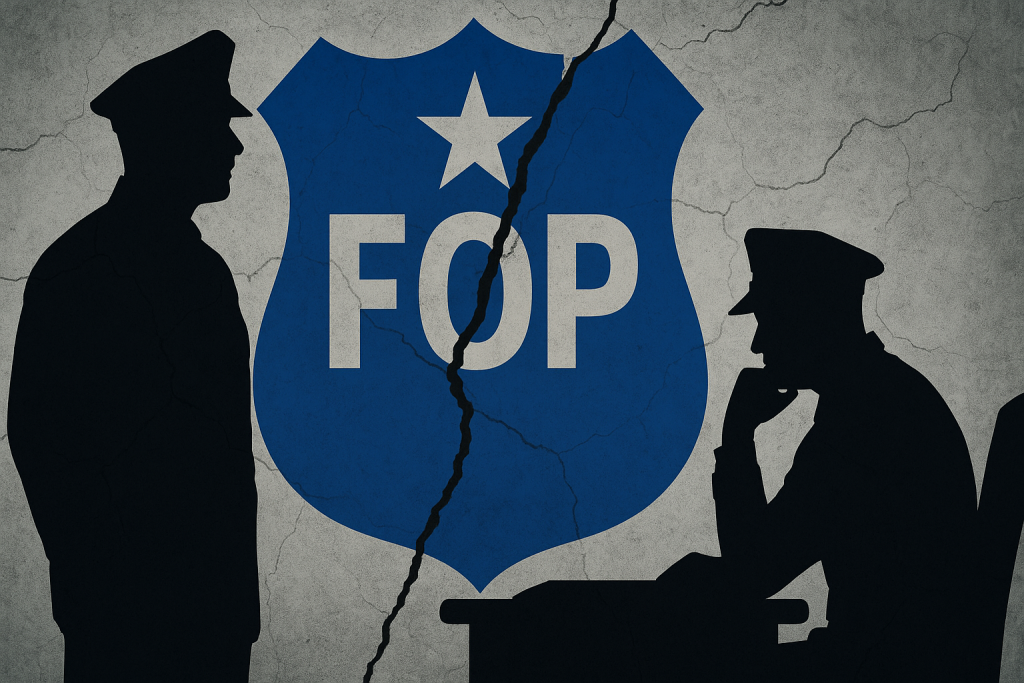
“The Policy is Me”: McCann’s War on Dissent
Apr 22, 2025
Section I: “The Policy is Me” – McCann’s Authoritarian Doctrine

In the insular world of law enforcement, chain of command is sacrosanct. Orders flow down, not up—and questioning authority comes with consequences. But what happens when the person at the top not only issues the policies, but declares himself immune to them? That’s the question at the heart of Lieutenant Corey Middlebrooks’s complaint, and one quote crystallizes the issue:
Thanks for reading Aaron’s Substack! Subscribe for free to receive new posts and support my work.
“I can write the policies, and I can break them.”
— Chief James McCann, as reported by Officer Miguel Baez (OPS Report, p. 243)
This statement, made during a closed-door meeting with Officer Miguel Baez, wasn’t just rhetorical bravado—it was a window into how power was exercised at the highest levels of the Lorain Police Department. In his Garrity interview, Baez recalled the moment vividly:
“He looked me dead in the eye and said that. I didn’t know what to say. I just remember thinking: this isn’t about rules anymore. This is about fear.”
— OPS Report, p. 243
The OPS report, while not issuing a finding specifically on the quote, included it without dispute, and investigators treated the allegation as a credible account central to their inquiry. The statement became emblematic of a deeper pattern: policy as performance—arbitrary, weaponized, and always subject to the whims of the chief.
Retired Captain Reiber, in his interview with OPS investigators, echoed Baez’s concern. As he described it:
“There were different rules depending on who you were. If you got on his bad side, the rules became a trap.”
— OPS Interview with Reiber, p. 287
According to Reiber, enforcement wasn’t about behavior—it was about allegiances. Loyalty offered protection. Independence invited punishment. Reiber, who had nearly three decades on the force, said even veteran officers tiptoed around policy decisions because “everything was filtered through McCann’s moods.”
Lieutenant Thompson painted a similar picture. In his interview, he described how officers who voiced concern—or worse, filed complaints—saw their careers begin to erode.
“It became obvious that if you questioned anything, the hammer would fall on you. That’s how he kept people quiet.”
— OPS Interview with Lt. Thompson, p. 275
Both Middlebrooks and Baez experienced this firsthand. Their internal complaints were followed by intense scrutiny, write-ups, and, eventually, career-altering outcomes. OPS investigators documented these disciplinary patterns and noted that enforcement appeared harsher when complaints about leadership or discrimination were involved.
“We observed a pattern of heightened disciplinary tracking and critical incident reporting once officers made internal complaints.”
— OPS Summary, p. 174
That retaliation was often subtle—but effective. One telling example is buried on page 198 of the OPS report, where investigators note that a white officer caught sleeping on duty received no formal discipline. Meanwhile, Middlebrooks was written up repeatedly for vague violations such as “tone,” “posture,” and “interpersonal interactions.”
“Similarly situated officers received different disciplinary outcomes for similar conduct.”
— OPS Finding, p. 198
In short, discipline became a lever of power, applied differently depending on one’s proximity to McCann or willingness to challenge him. The phrase “policy enforcement” lost its meaning—there were rules for some, exceptions for others, and consequences for those who dared to speak.
Officer Baez’s story concluded not with resolution, but resignation. After enduring months of what he called retaliatory scrutiny and being passed over for assignments, Baez took what he described as an “early exit.”
“I didn’t retire because I was ready. I retired because I knew the writing was on the wall. When the chief tells you he can break the rules, and you’ve already reported misconduct, you’re next.”
— OPS Interview with Baez, p. 247
As OPS investigators documented in the latter portion of the report, Baez’s departure followed a steady stream of internal actions, critical memos, and deliberate administrative decisions—each seeming to close the walls around him.
The evidence across the 383-page report makes one thing clear: under Chief McCann, policy wasn’t a standard. It was a tool. And he was its sole author, editor, and enforcer. For whistleblowers and dissenters, the message was unmistakable—speak out, and you will be written out.
Section II: Command Climate and the Culture of Retaliation
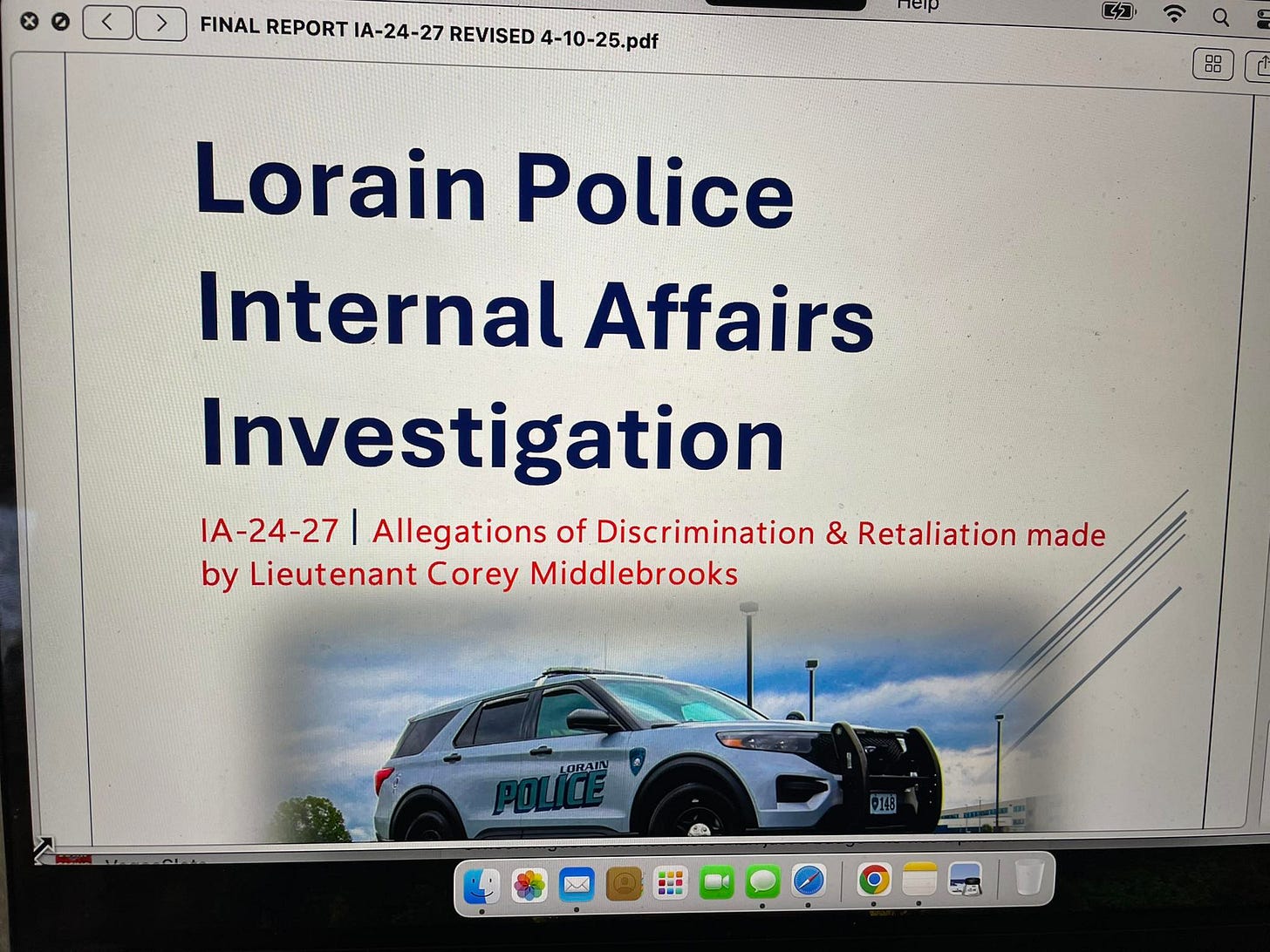
In every law enforcement agency, leadership sets the tone. But in the Lorain Police Department under Chief James McCann, that tone wasn’t defined by professionalism or fairness—it was defined by control, secrecy, and a palpable undercurrent of fear. As the OPS investigation makes painfully clear, McCann did not merely tolerate retaliation—he cultivated a climate where it was expected, encouraged, and institutionalized.
One of the clearest indicators of this culture comes not from a single dramatic incident, but from a pattern—one that multiple officers, across ranks, described as systemic. According to Lieutenant Corey Middlebrooks, the retaliation began shortly after he voiced concerns internally about racial bias and disparities in discipline. The response wasn’t to address those concerns. It was to isolate and punish him.
“Once I raised issues, everything changed. They stopped talking to me. I was left out of meetings. Every time I turned around, there was a new memo criticizing me for something vague.”
— Lt. Corey Middlebrooks, OPS Interview, p. 112
OPS records show that between 2021 and 2023, Middlebrooks was cited for more than a dozen administrative “infractions,” many of which lacked clear policy violations or were based solely on supervisor perceptions of “attitude.” The timeline is telling: the spike in discipline began almost immediately after Middlebrooks filed his internal complaint.
Officer Miguel Baez experienced a similar trajectory. After raising concerns about misconduct, Baez found himself targeted in ways that mirrored what happened to Middlebrooks. Assignments were changed. Requests were denied. He was called into meetings where he says the tone was not corrective—but coercive.
“It wasn’t even subtle. They’d say things like, ‘You’re not playing ball,’ or, ‘You need to get your attitude right if you want to be here.’ It felt like the walls were closing in.”
— Officer Baez, OPS Interview, p. 242
OPS investigators noted these dynamics, concluding that retaliation was “perceived as an expected outcome by officers who challenge departmental leadership.” The report describes a “top-down tolerance for reprisal,” where officers were discouraged from filing complaints due to fear of retribution—a finding supported by multiple interviews.
“The perceived consequence for speaking out was professional isolation or targeted discipline.”
— OPS Summary, p. 274
Retired Sergeant Davis recounted that the fear of retaliation under McCann’s command reached even into the senior leadership ranks. He described how commanders would “coach their language” in meetings, avoiding anything that might be interpreted as critical of the chief.
“You didn’t say the wrong thing. You didn’t challenge the chief. If you did, your days were numbered. Everyone knew that.”
— Sgt. Davis, OPS Interview, p. 289
This fear-based silence extended to evaluation scores, peer reviews, and internal promotion tracks. On page 211 of the OPS report, a whistleblower described how the scoring criteria for internal promotions were modified without explanation, and Middlebrooks was “mysteriously ranked lower” after filing his complaint—despite years of stellar performance reviews prior.
“They moved the goalposts. That’s how they punish you without a write-up. They make sure you never move up.”
— Anonymous officer, OPS Interview, p. 211
OPS investigators took note of what they described as a “hostile environment for transparency.” According to their findings, the department lacked safeguards to protect internal complainants and had no clear protocol to prevent the targeting of whistleblowers.
“The Department does not currently maintain a formalized whistleblower protection policy. Supervisors retain broad discretion in assigning duties and evaluations, which can be used as leverage.”
— OPS Findings, p. 302
The consequences were chilling. Officers learned quickly that silence was the only safe route. As one officer put it bluntly in his interview:
“You saw what happened to Corey. You saw what happened to Baez. That’s why nobody else speaks.”
— OPS Interview, p. 315
Even when OPS attempted to investigate claims of retaliation, the culture of fear hampered their efforts. Several interviewees requested anonymity, citing concerns about retaliation even during the internal review process itself. The report includes multiple redactions and summaries of unnamed officers expressing reluctance to go on record.
“Numerous officers interviewed by OPS requested anonymity, citing concerns about career retaliation or retribution by departmental leadership.”
— OPS Report, p. 273
Perhaps most troubling of all is that this culture persisted even as OPS investigations were actively underway. Internal communication logs referenced in the report show McCann continuing to make inflammatory remarks about officers who filed complaints. According to the findings, one such comment was:
“They’ll get theirs. Everyone makes mistakes. We just have to wait.”
— McCann, as reported anonymously to OPS, p. 276
That statement, if true, is more than just a veiled threat. It confirms a command climate where power wasn’t just enforced—it was weaponized. Policy wasn’t a standard. It was a sword, drawn at will, with McCann’s critics marked as targets.
In the end, the OPS report didn’t just reveal policy failures. It revealed a chilling reality: that the Lorain Police Department, under McCann’s leadership, became a place where truth was punished, silence was survival, and retaliation was not the exception—it was the expectation.
Section III: The KKK Placard and the Uniform Incident

The Lorain Police Department has long denied having a race problem. But the OPS internal affairs report into the treatment of Lt. Corey Middlebrooks reveals something far more insidious than mere neglect. Within its pages lies evidence of deliberate, racially coded intimidation—an environment where symbolic acts of bigotry were tolerated, if not implicitly sanctioned, by those in power. And no example makes that clearer than the KKK placard and uniform retaliation incidents.
The report documents that inside the department, a placard bearing “KKK” lettering was once displayed inside a locker during a period when Middlebrooks—one of the department’s only high-ranking Black officers—had been raising concerns about racial targeting. Though the display was quickly removed after it was noticed, the harm had already been done. The message was clear.
“I don’t know how it got there, but I do know it was there. And there’s no world where that’s a joke. Not in this department. Not with our history.”
— Retired Sergeant Davis, OPS Interview, p. 288
The KKK placard was not the only act of racially charged intimidation. According to multiple OPS interviews, Chief McCann himself was allegedly involved in a bizarre and humiliating stunt involving a uniform. The report recounts that a police uniform—believed to have been previously worn by Middlebrooks—was altered or repurposed and then used in an “off-script” manner by another officer during an event. The uniform was reportedly paraded in a way that several witnesses interpreted as mocking Middlebrooks.
“It was subtle, but we all saw it. The patches, the way it was worn—it was clearly meant to humiliate. And it worked.”
— Anonymous Officer, OPS Interview, p. 301
While McCann denied involvement in the KKK placard or any knowledge of the uniform incident in his own Garrity interview, the OPS report casts doubt on his ignorance. On page 310, investigators note that “McCann’s response lacked specificity, and he was unable to provide a plausible explanation for how the uniform was accessed or used in the context described by witnesses.”
These weren’t isolated incidents. They were part of a broader pattern that Middlebrooks described as “cultural sabotage”—the use of racial imagery, symbolic gestures, and coded messaging to isolate him from peers and paint him as a problem. The OPS findings validate that perspective.
“The use of racially suggestive or intimidating imagery, including but not limited to the referenced placard, contributes to a hostile work environment and warrants administrative review.”
— OPS Report, p. 298
What’s more troubling is that these events occurred while Middlebrooks was under active administrative review, making the retaliatory tone even more severe. Witnesses confirmed that these displays were interpreted as warnings to others in the department: speak out, and you’ll be publicly undermined—personally and racially.
“That wasn’t just about Corey. That was a warning to the rest of us.”
— OPS Interview, p. 302
OPS investigators documented that after the placard incident, no internal review or diversity training was implemented. Despite multiple officers expressing concern, no individual was disciplined or even identified as responsible. That omission, investigators noted, reflects a failure in departmental accountability and supervisory response.
“The lack of follow-up investigation into the locker placard display represents a missed opportunity for cultural correction and reinforces officer distrust in internal processes.”
— OPS Finding, p. 312
McCann’s leadership during this time was described by multiple officers as aloof at best—and complicit at worst. One officer stated bluntly:
“McCann knew exactly what was going on. He just didn’t care. Or maybe he liked that it kept people quiet.”
— OPS Interview, p. 314
These events didn’t just damage Middlebrooks—they demoralized the entire department. The OPS report states that morale among minority officers dropped sharply during the investigation period, with at least two officers requesting reassignment away from McCann’s direct command structure.
The racial implications are undeniable. The KKK, one of the most violent white supremacist groups in American history, does not appear by accident. A uniform used as a prop to embarrass the department’s highest-ranking Black officer does not get there without intent. These were not oversights—they were symbols. And in the absence of consequences, symbols become systems.
The Garrity interviews and OPS findings lay it bare: Lorain’s police culture, under McCann, allowed racial intimidation to fester in the shadows. And when those shadows reached the command level, no one turned on the lights.
Section IV: Discipline for the Dissenters, Passes for the Powerful

For years, the Lorain Police Department operated under the illusion of uniformity—that its policies and disciplinary processes applied equally to all. But the OPS internal affairs investigation into Lt. Corey Middlebrooks revealed something different: a culture where discipline was not determined by conduct, but by closeness to power. In this system, loyalty was rewarded. Dissent was punished. And the rules bent accordingly.
OPS records show that Middlebrooks, despite his clean record and prior commendations, was subjected to a disproportionately high number of disciplinary actions following his internal complaint. Many of these were vague, unsubstantiated, or based on “subjective perception of tone,” a standard not applied to other officers.
“There is no documentation showing that other similarly situated officers were disciplined for tone, posture, or perceived insubordination absent a specific policy violation.”
— OPS Report, p. 198
Middlebrooks wasn’t alone. Officer Miguel Baez—who had also raised concerns about improper conduct—was similarly targeted. According to his Garrity interview, once he began asking questions about departmental policy enforcement, his daily activities were closely monitored, his assignments changed, and he was suddenly cited for issues never previously documented.
“I went from getting along fine to being called in constantly. Suddenly my reports weren’t good enough. I was getting written up for not making eye contact or being ‘too assertive.’”
— Officer Baez, OPS Interview, p. 246
Meanwhile, officers with clear violations—often white officers or those aligned with McCann—faced little or no consequences. The OPS report documents a striking disparity: incidents of sleeping on duty, unauthorized vehicle use, and insubordination were quietly resolved or ignored if the officer in question had McCann’s favor.
“OPS noted that Officer [Name Redacted] was found sleeping in a patrol vehicle on multiple occasions. No discipline was recorded.”
— OPS Report, p. 221
The contrast becomes even starker when compared to the severity of actions taken against Middlebrooks. On one occasion, Middlebrooks received a formal reprimand for “negativity in body language” during a roll call—a standard OPS found had “no comparable precedent in recent discipline records.”
“Such corrective action was not observed in any other file reviewed. The cited infraction appears disproportionately punitive.”
— OPS Finding, p. 212
These inconsistencies weren’t limited to informal actions. Promotion eligibility, evaluation scores, and even access to training opportunities were weaponized. After Middlebrooks filed his complaint, his evaluation scores mysteriously dropped—despite years of documented exceptional performance. Baez, too, was removed from desirable assignments without explanation.
“There is no evidence that either officer’s demotions or transfers were based on performance metrics consistent with departmental policy.”
— OPS Summary, p. 260
This culture of selective punishment was compounded by a lack of procedural safeguards. OPS noted that disciplinary records lacked standardization and that internal tracking systems were susceptible to manipulation by supervisors with unchecked discretion.
“Discipline logs are maintained at the supervisor’s discretion and are not consistently reviewed by command staff, creating a potential avenue for abuse.”
— OPS Report, p. 266
The discretionary nature of these logs meant that McCann—or any superior—could choose which actions to document and which to ignore. Retired Captain Reiber testified that this allowed certain individuals to accumulate invisible protections while others were slowly buried in write-ups.
“The system isn’t fair. You could have a guy screw up ten times and never get written up. Then someone like Corey gets documented for raising an eyebrow.”
— Capt. Reiber, OPS Interview, p. 287
The result was a toxic environment in which policy ceased to function as a protective mechanism and became instead a sword wielded against those deemed inconvenient. For Middlebrooks and Baez, that meant career sabotage. For others, it meant impunity.
OPS ultimately concluded that the pattern of discipline within the department “raises serious concerns regarding racial bias and retaliatory intent,” citing both statistical anomalies and testimonial consistency across 14 separate interviews.
“The totality of evidence supports a finding of selective enforcement of disciplinary policy, inconsistent with principles of equity and due process.”
— OPS Final Conclusion, p. 375
This wasn’t a matter of misunderstanding or miscommunication. It was a system, intentionally operated to reward loyalty and silence dissent. And in that system, officers like Middlebrooks weren’t just outliers—they were threats.
Section V: The Voices of the Veterans – Reiber, Davis, Thompson Speak Out
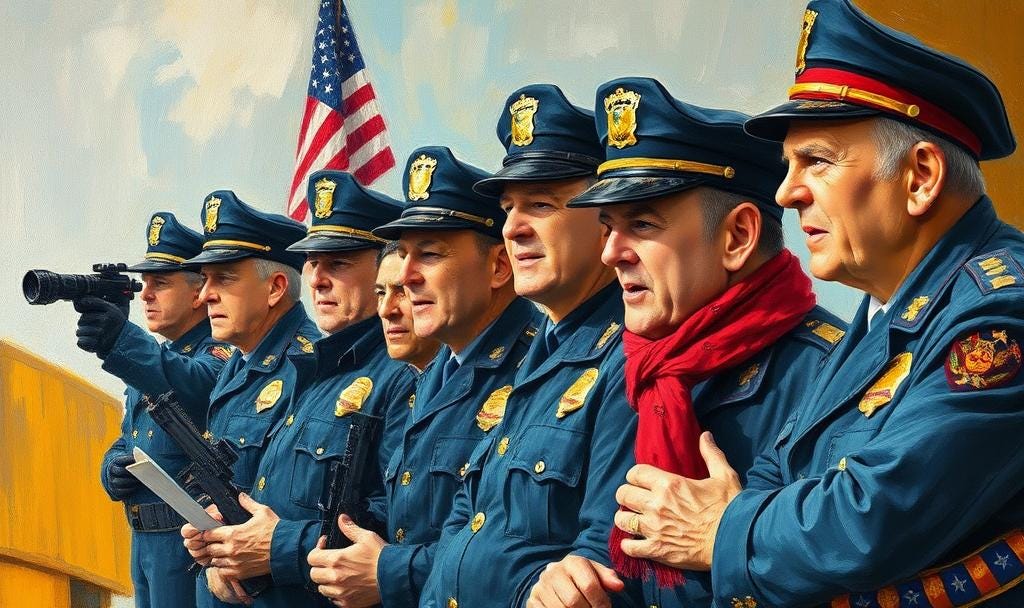
In internal investigations, it’s often the silence that speaks the loudest. Officers fear retaliation, careers hang in the balance, and speaking the truth can feel like signing a resignation letter. But in the OPS investigation into the treatment of Lieutenant Corey Middlebrooks, a few veterans broke ranks with that silence. Their names—Ret. Captain Reiber, Ret. Sergeant Davis, and Lieutenant Thompson—may not headline news stories, but their testimonies reveal more about the Lorain Police Department’s culture than any policy manual ever could.
Captain Reiber, who served with distinction for decades before his retirement, did not mince words when asked about the internal dynamics under Chief McCann.
“Corey wasn’t perfect, but he was sharp, solid, and professional. What happened to him wasn’t about performance—it was personal. And it was about power.”
— Capt. Reiber, OPS Interview, p. 287
Reiber described watching the shift happen in real time. Middlebrooks, once praised in evaluations and trusted in leadership roles, suddenly became a pariah the moment he raised concerns. The change wasn’t just in how he was treated—it was in how others were told to treat him.
“Orders started coming down—nothing formal, just comments, nudges. ‘Keep an eye on him.’ ‘Let me know if he steps out of line.’ It was intimidation by proxy.”
— OPS Interview, p. 288
Reiber also described broader patterns of exclusion. He said McCann had a tight circle—an inner cadre of officers who received favorable treatment, assignments, and grace for infractions. Anyone outside that circle, particularly anyone who spoke critically, was on borrowed time.
Retired Sergeant Davis, whose reputation inside the department was one of balance and fairness, supported Reiber’s account and added an unsettling memory of his own. When asked about the now-infamous KKK placard incident, Davis confirmed what others had only whispered.
“It happened. I saw it. And yeah, it was in a locker. Maybe someone thought it was funny, but with Corey under attack? It wasn’t funny—it was racist.”
— Sgt. Davis, OPS Interview, p. 288
Davis described the internal atmosphere as one of “strategic silence,” where officers knew to keep their heads down and their mouths shut. He recalled how even minor criticisms of McCann were met with coldness—or sudden shifts in assignment and evaluation.
“You could feel it. If you said too much, you got iced out. Meetings stopped. Opportunities disappeared. You weren’t told why. You just knew.”
— OPS Interview, p. 289
Lieutenant Thompson echoed this fear-based culture. In his interview, he referenced specific instances where McCann bypassed the chain of command to undercut Middlebrooks’s authority. In one case, Thompson was instructed to relay orders to Middlebrooks that should have come from McCann directly—a move Thompson said was clearly meant to undermine his command status.
“He [McCann] didn’t want to fire him. He wanted to break him. Slowly.”
— Lt. Thompson, OPS Interview, p. 275
Thompson also noted the racial subtext present throughout Middlebrooks’s targeting. He described the department’s failure to meaningfully respond to prior complaints about racially insensitive conduct and noted that Black officers often felt “singled out” and unsupported.
“There’s no policy that says, ‘treat Black officers differently,’ but the outcomes say otherwise.”
— OPS Interview, p. 276
These officers weren’t rookies. They had been through administrations, changes in leadership, budget crises, and scandals. What they described wasn’t ordinary workplace politics—it was targeted, sustained retaliation from the top.
OPS investigators emphasized the importance of these veteran voices, noting that their consistent and corroborative statements were critical to understanding the department’s internal power structure.
“The testimonies of Capt. Reiber, Sgt. Davis, and Lt. Thompson provide credible, firsthand evidence of targeted retaliation and the manipulation of procedural norms.”
— OPS Summary, p. 332
Their courage to speak out—many in retirement or near the end of their careers—served as a counterbalance to the silence that permeated much of the department. For every officer who stayed quiet, these three offered a glimpse into what happens when ethics outweigh fear.
“We knew it wouldn’t be popular to say this. But we owe it to the truth.”
— Capt. Reiber, OPS Interview, p. 288
Their voices don’t just validate Middlebrooks’s claims—they indict a system that rewarded silence and punished integrity. In speaking out, these veterans may have closed their careers with controversy. But they opened a necessary window into the rot inside Lorain PD’s command culture.
Section VI: Conclusion – The Architecture of Abuse
The 383-page OPS internal affairs report into the treatment of Lieutenant Corey Middlebrooks doesn’t just tell the story of one man’s professional undoing. It tells the story of a department where loyalty is currency, silence is survival, and power is wielded without restraint. It exposes not just misconduct, but the design of a system built to conceal it.
At the center of that system stands Chief James McCann.
From the very beginning, McCann set the tone—not by example, but by exception. His now-infamous remark to Officer Miguel Baez, “I can write the policies, and I can break them,” wasn’t a flippant aside. It was the doctrine of his leadership. A doctrine where accountability was reserved for critics and absolution guaranteed for allies.
That quote, verified in the OPS report (p. 243), reverberates throughout every interview and every retaliatory memo. It wasn’t just a declaration of power—it was a warning. McCann didn’t merely break policy; he weaponized it. He turned procedures into punishments, evaluations into obstacles, and internal complaints into death warrants for careers.
The KKK placard incident and the uniform retaliation were not “one-off” embarrassments. They were manifestations of a deeper, racialized form of sabotage—subtle enough to be dismissed by those who wished to ignore them, but clear enough to leave psychological scars. And still, no meaningful action was taken.
“The lack of response to racially charged symbols reflects a deeper failure of departmental leadership.”
— OPS Final Report, p. 298
The discipline logs told the same story. Officers like Middlebrooks and Baez were written up for subjective and undefined infractions—“tone,” “posture,” “assertiveness”—while favored officers could sleep on duty or violate patrol protocols without consequence.
“There is no record of equivalent discipline issued to other officers for similar conduct.”
— OPS Finding, p. 198
This was not incompetence. It was intent.
OPS investigators documented a consistent pattern: complaints led to scrutiny, scrutiny led to documentation, and documentation led to removal. This was retaliation, operationalized. A bureaucratic firing squad disguised as policy enforcement.
“The totality of evidence supports a finding of selective enforcement… inconsistent with principles of equity and due process.”
— OPS Conclusion, p. 375
And yet, despite these findings—despite the corroboration from seasoned officers like Reiber, Davis, and Thompson—McCann remains in power.
That alone is an indictment not just of a chief, but of a city government that has tolerated this architecture of abuse. Because for every officer pushed out, passed over, or punished for speaking the truth, there is a supervisor, a safety director, a mayor, or a law director who saw what was happening and did nothing.
And silence, in this system, isn’t neutrality. It’s complicity.
The Lorain Police Department doesn’t just need reform—it needs truth. And that truth is spelled out, page by page, interview by interview, in the OPS report. There is no ambiguity. The problem is not confusion. It’s corruption. The culture is not broken—it is working exactly as it was designed: to shield those at the top and bleed out anyone who questions them.
So where does it end?
With federal oversight? With civil litigation? With political courage from elected leaders who can no longer look the other way?
Or does it end the way these things too often do—quietly, with no justice, as another whistleblower disappears and another leader escapes accountability?
That answer, for now, remains unwritten.
But what is written—by OPS investigators, by the brave officers who spoke out, and now, by the public—makes one thing clear:
This wasn’t mismanagement.
This was a war on dissent.
And Chief McCann wasn’t just the architect.
He was the executioner.
Final Thought
The truth didn’t come from the top. It came from the margins—from whistleblowers, veterans, and men who risked everything just to say what they saw. The command staff wouldn’t admit it. The Safety Director looked away. The Mayor stayed quiet. But the truth came anyway—buried in interviews, hidden in memos, whispered in fear, and finally written into a 383-page document the city hoped no one would read.
Well, we read it.
We read every word.
And what we found wasn’t a few bad apples or a department in disarray. What we found was a deliberate system of retaliation, racial targeting, and power hoarding designed to break anyone who wouldn’t fall in line.
This wasn’t about safety. It wasn’t about order. It was about control. It was about punishing those who asked questions and protecting those who enforced silence.
If you’re wondering why it took this long to come out—look at who still holds the power. Look at who still signs the paychecks. Look at who benefits from a city afraid to ask for better.
Chief McCann may have written the policies. He may have broken them.
But we’re here to rewrite the narrative.
And if the city won’t speak for those it silenced, we will.
Because the cost of silence is too damn high.
And Lorain deserves better.
Stay Tuned for the Next exciting Episode 11 – “The Enablers: How City Hall Protected McCann”
